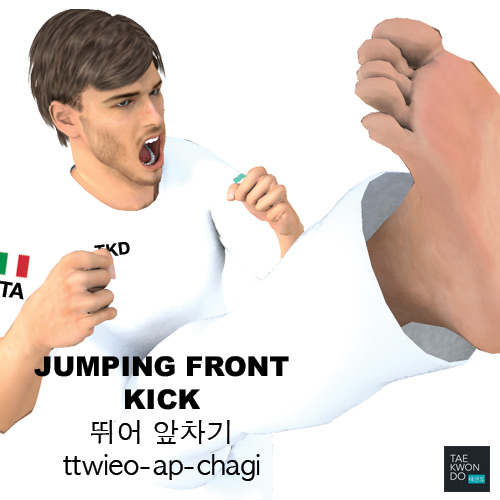Taekwondo 태권도Taekwondo Preschool
Promotion from one geup to the next can proceed rapidly in some schools, since schools often allow geup promotions every two, three, or four months. Students of geup rank learn the most basic techniques first, and then move on to more advanced techniques as they approach first dan. Many of the older and more traditional schools often take longer to allow students to test for higher ranks than newer, more contemporary schools, as they may not have the required testing intervals. View Taekwondo belt levels »

Jumping Front Kick
뛰어 앞차기 ttwieo-ap-chagi
A kick (차기 chagi) is a physical strike using the foot, leg, or knee. The striker relaxes to the extent possible during the strike, tensing the muscles of much of the body only at the time of impact, then relaxing again to recoil the striking part. Relaxation enables the strike to achieve the greatest possible velocity during travel, while rigidity at impact allows the maximum transfer of force.
Difficulty Level: Beginner Technique: Kick ( 차기 chagi )
The Jumping Front Kick ( 뛰어 앞차기 ttwieo-ap-chagi ) is a beginner level kick ( 차기 chagi ) that is taught to taekwondo practitioners to perform a Front Kick ( 앞차기 ap-chagi ) while in the air, and then landing safely on both feet. This kick ( 차기 chagi ) is typically performed in patterns ( 품새 poomse ), breaking ( 격파 gyeokpa ), promotion tests and demonstrations.
In practice, the kick ( 차기 chagi ) involves pulling up the back leg to help gain height during the jump and then performing the kick ( 차기 chagi ) itself with the front leg.
Suitable attacking targets for the Jumping Front Kick ( 뛰어 앞차기 ttwieo-ap-chagi ) are the chin ( 턱 teog ) and the jaw ( 턱 teog ) of the opponent. If done improperly, the practitioner may well break their toes, trip over their feet or twist their ankles ( 발목 balmog ).
Taekwondo practitioners may include a shout or yell ( 기합 kihap ), to help tense the muscles at impact and distract or frighten the opponent. Practitioners generally exhale as the kick ( 차기 chagi ) nears the target. Breath control is also important to relax the body when not attacking; novice practitioners often waste significant energy because they are tense at inappropriate times.
Other Jump Kick ( 뛰어차기 ttwieo-chagi ) Variations
- Flying Kick ( 두발당성차기 dubaldangseong-chagi )
- Jump Kick ( 뛰어차기 ttwieo-chagi )
- Jumping Front Kick ( 뛰어 앞차기 ttwieo-ap-chagi )
- Jumping Side Kick ( 뛰어 옆차기 ttwieo-yeop-chagi )
- Jumping Back Thrust Kick ( 뛰어 뒤차기 ttwieo-dwi-chagi )
- Jumping Turn Kick ( 뛰어 돌려차기 ttwieo-dollyeo-chagi )
- Jumping Axe Kick ( 뛰어 내려차기 ttwieo-naeryeo-chagi )
- Jumping Inward Crescent Kick ( 뛰어 안차기 ttwieo-an-chagi )
- Jumping Outward Crescent Kick ( 뛰어 바깥차기 ttwieo-bakkat-chagi )
- Jumping Back Whip Kick ( 뛰어 뒤후려차기 ttwieo-dwi-huryeo-chagi )
- Jumping Flip Kick ( 공중제비차기 gongjungjebi-chagi )
- Jump Two-Foot Front Kick ( 뛰어 두발 앞차기 ttwieo-dubal-ap-chagi )
Training Methods
How well one improves with training depends on several factors, such as the frequency it is engaged in, and the type of feedback that is available for improvement. If a student does not train often enough, reinforcement fades, and he or she is likely to forget what was learned.
The kick ( 차기 chagi ) is best learned initially striking at the air as though there is an opponent but focusing on the form, speed, control, and technique; then moving on to soft surfaces striking punch mitts and target pads. Large heavy bags are used more for strength and endurance, while smaller targets such as punch mitts and target pads focus on faster kicking speed, timing and coordination. Target pads are useful for training mobility and accuracy on a moving target.
Difficulty of Technique
Taekwondo students of geup ranking learn the most basic techniques first, and then move on to more advanced and difficult techniques as they approach 1st Dan Black Belt. The more difficult the technique, the more practice may be needed for the purpose of improving or mastering it, as in the phrase 'practice makes perfect'. Every technique must display the requisite speed, balance, power and firmness to be realistically used as an attack or defense move.
* Please see a certified Master Instructor ( 사범님 sabeomnim ) for training. Proper guidance and instructions are needed to ensure safe training.
Promotion Tests
Students often undergo periodic testing and grading by their own Master Instructor ( 사범님 sabeomnim ) in order to advance to a higher level of recognized achievement such as a different belt color. They need to demonstrate their proficiency in the various aspects of the art such as the execution of patterns ( 품새 poomse ), which combine various techniques in specific sequences.
Jumping Front Kick ( 뛰어 앞차기 ttwieo-ap-chagi ) is a requirement for the below belt levels (Techniques vary between schools). Promotion from one belt level to the next can proceed rapidly in some schools, since schools often allow geup promotions every two, three, or four months. Students of geup rank learn the most basic techniques first, and then move on to more advanced techniques as they approach first dan black belt. View Promotion Tests »

Training Highlights Summary
The Kick ( 차기 chagi ) contains many key point highlights. There are some that are simple and straightforward but then some are complex and detailed that require repeated training to learn and master.
- practitioner to perform a Front Kick ( 앞차기 ap-chagi ) while in the air, and then landing safely on both feet
- usually delivered through the ball of the foot ( 앞축 apchuk ), or with flat upperside (instep) of the foot ( 발등 baldeung )
- the height to which it is delivered will also influence the way it is delivered
- hips movement may be used to increase the reach and to thrust one's leg into the target, resulting in a more powerful strike
- effective accomplishment of the Jumping Front Kick ( 뛰어 앞차기 ttwieo-ap-chagi ) relies on mental preparation combined with an athletic condition
Strength Requirement of the Technique
Most strikes should generally be thrown with some measure of shifting body weight supporting the blow. The striker in combat should attempt to strike through the target area, not just contact the surface. Some strikes do not need as much strength as they target vulnerable areas such as the eyes ( 눈 nun ), neck ( 목 mok ) or sternum ( 흉골 hyung-gol ). The below is an approximate measurement of how much strength the strike requires from the practitioner to be effective.
Precision of Kicking ( 차기 chagi ) Technique
With proper execution opponents may be stopped with a single striking blow, which lessens the number of further strikes. Some kicks ( 차기 chagi ) can strike with more precision which will often cripple or knockout the opponent. The below is an approximate measurement of how precise the kick ( 차기 chagi ) requires from the practitioner to be effective.
Experienced practitioners learn through repetition and muscle memory when (not just how) to launch particular kicks ( 차기 chagi ), based on the circumstances they are facing.
* Please see a certified Master Instructor ( 사범님 sabeomnim ) for training. Proper guidance and instructions are needed to ensure safe training.
Risk of injury can be reduced by completing an effective warm up consisting of a heart raiser to get your pulse up, followed by sport specific dynamic stretches (stretches whilst moving). Please follow the guidance of a certified Master Instructor or trainer when doing sports related activities. Depending on the intensity of the exercise, cooling down can involve a slow jog or walk, or with lower intensities, stretching can be used. Cooling down allows the heart rate to return to its resting rate. View more information on Warming Up and Cooling Down ».
This article uses material from the Wikipedia articles "Warming Up" and "Cooling Down", which is released under the Creative Commons Attribution-Share-Alike License 3.0.
There are five tenets defined in the International Taekwondo Federation (ITF) and several more in World Taekwondo (WT).
Courtesy ( 예의 ye-ui ): "Showing courtesy to all, respecting others, having manners as well as maintaining the appropriate etiquette at all times, both within and outside the dojang (도장) (designated training area)." View Taekwondo Tenets »
RESOURCES
This article uses material from the Wikipedia articles "List of Taekwondo Techniques" and "Kick" which is released under the Creative Commons Attribution-Share-Alike License 3.0.







































